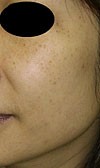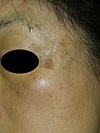Freckles

The proper medical name is ephelides. Most people know what they look like. These are small brown spots mainly over the cheeks. They appear and increase in number, size and colour with sun exposure. Although they are common in Asian, they are more common in red-haired, blue-eyed individuals who burn rather than tan in the sun.
Freckles are easily removed by different laser treatments. Usually one single treatment can remove them almost completely.
Solar Lentigines (Liver Spots)
 |
 |
Lentigines are larger and darker than freckles and may have irregular edges. They occur mainly on sun-exposed skin and the next commonest place after the face is the back of the hands. Their numbers increase with increasing age as the ‘’dosage’’ of sun exposure accumulates.
They can be treated again with different lasers, but unlike freckles, they usually require more than 1 treatment, but no more than 2 or 3.
Melasma
Another name is chloasma. They are large, light to dark brown blotchy patches. They develop, usually symmetrically, slowly over the forehead, cheeks and moustache area.
 |
 |
No one knows how it comes on but it occurs most commonly during pregnancy and can be related to the use of contraceptive pills. The chance is as high as 50 to 70% in pregnant women and 8 to 29% in women taking the pills. They fade after delivery or stopping the pills, but may be permanent. Again they become more obvious after sun exposure.
There are 3 types of melasma: superficial (we call it epidermal type); deep (dermal type); and the mixed (epidermal-dermal type). The doctor can tell the difference by shining ultra-violet light on it. The main thing is that only the superficial part can be effectively treated with bleaching agents.
Melasma is notoriously difficult to treat with the various pigment lasers. Frequently it may not respond, and in some cases it may actually worsen. However, with the new addition of fractional lasers, particularly the CO2 laser, there is a new hope. It has been shown that after 2-6 treatments, there is a marked reduction in both epidermal and dermal pigmentation, with no relapse after 3 months.
Café-Au-Lait Spots
Café-Au-Lait is French for coffee with milk. So basically this is what they look like: flat, light tan to brown flat spots. Their sizes are very variable, from 2cm to 20 cm in diameter. Up to 13% of the population has one or more of these spots. They may appear at birth or soon after and increase in numbers in subsequent years.

These spots are caused by an increase in melanin content with the presence of giant melanosomes.
To have a few such spots is totally normal. However, if there are 6 or more Café-Au-Lait spots in children or adults, and they are at least 15 mm in diameter in patients older than 5 years or over 5 mm in children younger than 5 years, it could be the sign of a disease known as neurofibromatosis, an inherited autosomal dominant disorder. This disorder can be highly variable in its expression, with members in the same family showing differing degrees of severity. Other features are required to make this diagnosis and some people may have multiple spots without having the disease.
The response to laser can be very variable. Sometimes 2 treatments can remove the spots completely, while other cases may need 5 or 6 treatments.
Post-inflammatory Hyper-pigmentation (PIH)
Any skin inflammation or injury down to the junction between the superficial and deep level will result in darkened skin. A very common cause is acne.
PIH is more common in the dark skin type of Asian people. Sometimes this slowly fades away if given enough time (as long as 1 year or more), but they can also be permanent.
Different treatment modalities have been tried. These include topical bleaching cream, micro-dermabrasion, chemical peeling, lasers etc. All work to a certain extend, sometimes very good effect, but to clear PIH completely 100% is rather not possible.
Naevus of Ota
This is a birthmark with unknown cause. This usually occurs on the upper and middle third of one side of face, but rarely can also happen on both sides. The ears, inside of mouth, and the sclera of the eyes can also be affected. This is most commonly found in Asians and Blacks and mainly affects women. About 1 - 2% of the Japanese population has it but it is very uncommon in Caucasians.
If the eye is affected, arrange for regular eye examinations to detect glaucoma.
On the skin, the colour ranges from bluish gray to dark brown, with an edge blends gradually with the adjacent normal skin. The melanin and melanocytes are found deep in the dermis and laser treatment is the only hope for fast and effective clearance. The most effective laser so far is the Q-switched type with a wavelength of 532, 694, 755 or 1064nm. However many sessions, frequently up to around 10, are required to clear it enough not to be noticeable. Recurrence is common after a few years.

